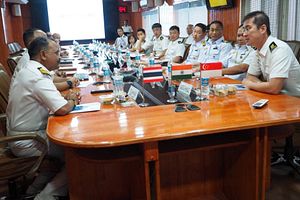Last week, Singapore and India officially announced publicly that the first-ever trilateral maritime exercise between them and Thailand would now be annualized. The development spotlights the ongoing development of the mechanism between the three countries amid wider regional developments in the Indo-Pacific region.
As I have observed before in these pages, one of the notable new exercises in the Indo-Pacific has been the so-called Singapore-India-Thailand Maritime Exercise (SITMEX). After being mentioned previously, the first iteration of the exercise was finally carried out between the Republic of Singapore Navy, the Indian Navy, and the Royal Thai Navy in September last year, including a shore phase at Port Blair and a sea phase featuring maneuvering, navigation and gunnery drills and boarding operations in the Andaman Sea.
While the exercise itself was modest in terms of its size – with five ships from the three navies over 500 personnel – it was not without significance as it attested to the intra-Asian security networking at work in the region as well as the role India continues to play with certain Southeast Asian states in operationalizing new instances of maritime collaboration in strategic spaces including the Andaman Sea. It also took place amid a series of broader developments, including the rising discussion of Indo-Pacific visions and increasing defense linkages among Southeast Asian states and between New Delhi and pivotal countries from the region.
Last week, SITMEX was in the headlines again with news about its annualization. The official public confirmation of its annualization came as Singapore and India held fourth iteration of their defense ministerial dialogue.
Per a joint statement released by the two sides following the Singapore-India Defense Minister’s Dialogue (DMD) led by Singapore Defense Minister Ng Eng Hen and visiting Indian Defense Minister Rajnath Singh, Singapore, India, and Thailand had “found value” in the exercise and had agreed to conduct the exercise on an annul basis. The exercise, the statement added, “underscores the shared responsibility of the countries to work together to keep sea lines of communications open, and strengthens interoperability between the three countries.”
Unsurprisingly, few additional specifics were disclosed by the two countries, with the inaugural exercise just having been carried out. But with the confirmation of the annualization of SITMEX, the focus will now shift to how the engagement can be expected to evolve into 2020 with its second iteration as well as beyond that, including potential indicators of expansion, the areas of focus, and the engagements that are carried out by the three countries. As we see SITMEX become a more regular feature in the Indo-Pacific exercise calendar, how the countries involve approach these issues and more will continue to be important to watch.

































